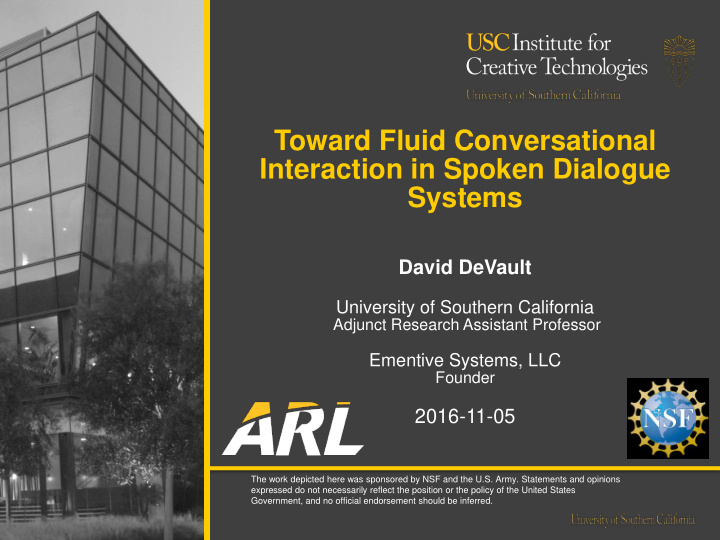



Toward Fluid Conversational Interaction in Spoken Dialogue Systems David DeVault University of Southern California Adjunct Research Assistant Professor Ementive Systems, LLC Founder 2016-11-05 The work depicted here was sponsored by NSF and the U.S. Army. Statements and opinions expressed do not necessarily reflect the position or the policy of the United States Government, and no official endorsement should be inferred.
12 Years of Spoken Dialogue Systems Research Conflict Resolution Agent Eve Agent SimSensei Kiosk (Gratch et al., 2016; (Paetzel et al., 2014, 2015; (DeVault et al., 2014; DeVault et al., 2015; DeVault et al., 2013) Manuvinakurike et al., 2015- Gratch et al., 2015) 2016) SASO-EN scenario COREF SASO4 scenario (Traum et al., 2008; (DeVault & Stone (Plüss et al., 2011; DeVault & DeVault et al., 2009-2011) 2005-2009) Traum, 2013; Traum et al., 2012) 2
Major “Uphill Battles” for Spoken Dialogue Systems Automatic speech recognition Broad coverage semantics Multi-domain / multi-application dialogue policies Fluid conversational interaction Turn-taking / mixed-initiative Incremental (word-by-word) speech processing Dialogue modeling 3
What isn’t “fluid” about talking to current SDSs? Nearly all SDSs use simplistic turn-taking protocols “Ping - pong” assumption (one DA per turn, no overlapping speech) All user-initiative / all system-initiative Users can’t tell if systems are understanding them High response latency, no backchannels (“uh huh”, nods) Users don’t know when they can speak or what they can say Single questions or commands: okay Anything else: completely unpredictable Interaction easy to derail Every single utterance is a heavy-weight decision for users 4
Example 1: The Eve Agent (Paetzel et al., 2014, 2015; Manuvinakurike et al., 2015-2016) 5
What’s interesting about Eve? Users strongly prefer this agent to versions with higher response latency Perceptions of efficiency, understanding, naturalness (Paetzel, Manuvinakurike, and DeVault, SigDial 2015; Best Paper Award) In small domains we can use modest amounts of data to build systems that understand user speech very well and very quickly But what about domains where richer models of understanding and turn-taking are needed? 6
Example 2: The Conflict Resolution Agent (Gratch et al., 2016; DeVault et al., 2015; Gratch et al., 2015) 7
What’s interesting about this? Support for a wide range of utterance types Mixed-initiative Fairly fast-paced interaction 8
How do we make progress? Stop making simplistic assumptions about turn-taking and the structure of individual turns Use better models of time in interaction Develop more extensive, more general, more data- driven dialogue models More and bigger human-human conversation data sets 9
Thank you! devault@usc.edu 10
Recommend
More recommend